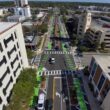BuySpeed e-procurement delivers bang for the buck in the bayou

In the wake of Hurricane Katrina, the rebuilding of New Orleans made it more important than ever for the city to modernize its cumbersome and inefficient paper-based purchasing process. Thanks to the Web-based BuySpeed e-procurement system, the city was able to accomplish that – saving more than $1.25 million along the way.
Since being implemented in 2006, BuySpeed has helped the city cut its processing time by 80 percent and increase its purchase orders by fivefold, even after staff cuts.
BuySpeed, which is a product of Austin, Texas-based Periscope Holdings, integrates with the city’s Microsoft Dynamics-GP general ledger system, and combines Web requisitioning, electronic approvals, contract purchases and electronic purchase-order delivery to reduce purchase cycle time citywide.
BuySpeed also gives the city self-service vendor registration and secure bid management, which reduce costs and improve the efficiency of the competitive bidding process.
Electronic receipt and invoice entry close the procurement loop by automating the entire “procure-to-payment” cycle.
The city’s initial investment in BuySpeed was $256,200, which included software and professional services for implementation and consulting. The initial cost of the BuySpeed system, when compared to the actual cost savings gained, delivered a 4:1 return on the city’s investment.
“BuySpeed was clearly the best solution we evaluated,” said Andrée Cohen, purchasing administrator for the city of New Orleans. “None of the other solutions came close to demonstrating the range of e-procurement functionality offered by Periscope, let alone Web-based.”
Paper-based process created headaches
In 1997, the city of New Orleans implemented a mainframe financial management system but elected not to implement any electronic purchasing functions. Instead, city staff manually processed and documented procurements. The lack of automation for purchasing processes created a range of problems for the city, including:
- No automated vendor management. The city had no automated process for registering and maintaining vendor information, which made it very difficult for departments to effectively source purchases. City staff received paper bid applications and manually input this information into the vendor database. The database contained duplicate vendor records and did not include city-required DBE certification and other retrievable vendor information.
- Time-consuming formal bidding. The purchasing staff spent a considerable amount of time documenting every step of the bidding process, including:
- Bid development and release.
- Written vendor notifications.
- Advertising.
- Tabulation.
- Document approval.
- Document security and management.
- Recommendation of award and contract.
- Inefficient requisitioning. The city’s Department of Purchasing was responsible for processing requisitions originating from departments citywide. Staff initiated these in the mainframe financial system but system limitations meant:
- Requisition status was not available during the approval process.
- Staff members had no ability to attach documents to the mainframe financial system.
- Data could not be automatically transferred onto bid and purchase order (PO) documents.
- Document tracking and reporting was not automated.
- Links to awarded POs were not available.
- Inability to access purchasing information. No centralized repository existed for those procurements in the process of negotiation or for those executed by the city. As a result, two different departments could have had completely separate bids or requests for proposal (RFPs) released for identical products or services with different vendors and contract terms. This increased costs for both goods purchased and contract management. Without a tightly integrated purchasing process, departments had insufficient information about purchases and document workflow. Consequently, the city had limited capabilities to know how and where its departments were actually spending funds.
- High administrative costs. Manual processes require very costly resources – people. In 2005, the city carried a staff of nine full-time buyers and three full-time administrators to support citywide purchasing. The city charter required purchasing staff to secure competitive pricing for all purchases. Louisiana State Public Bid Law requirements imposed varying rules based on the type of procurement and its total estimated price. On average, the staff hours required to issue each purchase order cost the city $80 and – in some cases – exceeded the cost of goods purchased.
Problems compounded by Katrina
Hurricane Katrina struck New Orleans on Aug. 29, 2005. More than 80 percent of the city remained under water for two weeks, and the city’s infrastructure was decimated.

The drinking water system was contaminated, gas lines were filled with salt water (corroding copper gas pipes) and power lines all across the community were down. Streets were unnavigable – except by boat – and hundreds of roads sustained severe damage because of their extensive exposure to saltwater. Katrina damaged or destroyed more than 100,000 homes and left 50,000 vehicles submerged.
The situation was exacerbated by Hurricane Rita re-flooding parts of the city when it made landfall on Sept. 24, about three weeks following Katrina.
After Katrina’s devastation, the New Orleans population was cut by more than half – to approximately 220,000 – and the city struggled to rebuild. Performance of many city services – including purchasing – became nearly impossible because of the loss of staff and resources such as computers, phones and available office space. Of the 12 staff members working in the Department of Purchasing prior to the hurricane, only three returned during the days immediately following Katrina.
More pressure than ever was put on the city’s purchasing process after this natural disaster. Hundreds of construction and capital improvement projects needed funding and management by the city as part of its rebuilding effort. The engineering and logistical challenges to support this required a substantial level of management, control and the coordination of thousands of suppliers and contractors.
The city needed to perform efficiently and respond rapidly to this crisis to bring order to the chaos left in the hurricane’s wake, and to handle the increased requisitions necessary to rebuild the community’s severely damaged infrastructure. The additional demands placed on the city’s purchasing system included the need to:
- Manage increased spending. Spending and procurement activity would continue to increase over the coming months and years as New Orleans’ rebuilding effort progressed. This activity could not be managed using the existing infrastructure.
- Rebuild the network of vendors that supply the city with goods and services. Following Katrina, many of the contract vendors previously in place for the city had moved or no longer were in business. The city had to immediately re-engage the vendor community and establish a usable database of providers.
- Increase productivity. The pre-Katrina staff of 12 was challenged to perform purchasing activities under normal circumstances with the previous processes and infrastructure. With only seven Department of Purchasing staff working after Katrina, the city had to dramatically improve staff efficiency and productivity by automating its manual processes.
BuySpeed software implemented

The city needed to perform efficiently and respond rapidly to this crisis to bring order to the chaos left in the hurricane’s wake, and to handle the increased requisitions necessary to rebuild the community’s severely damaged infrastructure.
Prior to Katrina, the city had recognized the deficiencies in its manual purchasing process and issued an RFP for an electronic purchasing system. The city’s primary objective was to acquire a Web-based purchasing system that would allow it to automate the requisition, bid, purchase order and contracting process, manage the vendor database and integrate with its financial system.
Just months before Katrina, the city awarded a contract to Periscope Holdings for its Web-based e-procurement software solution, BuySpeed. Periscope is an Austin, Texas-based company that providing e-procurement software and services to government clients across North America.
Under the contract, BuySpeed would be integrated with the city’s Microsoft Dynamics GP general ledger system. Periscope would provide professional services for the software’s implementation and consulting.
BuySpeed was set to go live the first week in September 2005. But just a few days before the new system’s planned launch, Katrina hit New Orleans and chaos ensued. Periscope quickly responded to the city’s call for help.
“The Periscope team worked quickly to establish a field purchasing environment that provided access to the state of Florida emergency supplier list,” Cohen said. “They also helped us procure desperately needed items such as computers and clothing.”
Periscope’s ‘priority project’
Periscope worked closely with the city not only to provide temporary disaster support but also to continue implementation of BuySpeed. The urgency to get the new system up and running was made ever more pressing by the inadequacies of the Federal Emergency Management Agency (FEMA)’s purchasing procedures implemented as a stopgap measure immediately following the disaster.
FEMA’s system gave the city little ability to track the history of purchases at a time when it was making an unprecedented number of them. The city was relying heavily on federal assistance and donations to fund recovery efforts. City officials knew they had to automate, control and account for the city’s spending or else compromise the city’s ability to continue to receive this funding.
“We knew it was critical for the future of New Orleans that the city get its automated system in place quickly – despite the unimaginable challenges faced after Katrina,” said Brian Utley, Periscope president and CEO. “It immediately became Periscope’s priority project.”
The city launched BuySpeed in March 2006. The software not only provided the functionality to address the problems the city had faced with its manual purchasing system but it also gave the city the ability to efficiently control and account for the increased purchasing necessary for the city’s reconstruction.
“BuySpeed did not require special features or functions that were unique to the city of New Orleans,” said Chris Kennedy, Periscope’s vice president of professional services. “New Orleans’ needs were very similar to those of many large municipal governments. BuySpeed is designed to meet the challenges unique to governments and purchasing professionals.”
Other large local governments, including Baltimore, Tucson, Ariz., and Harris County, Texas, rely on Web-based BuySpeed to manage their entire purchasing life cycle.
BuySpeed’s Web functionality addressed the multiple challenges the city of New Orleans had faced pre-Katrina under its manual system by providing:
- Improved vendor management. Self-service vendor registration and file maintenance now gives the city current and accurate vendor information. Emergency suppliers of goods and services can be identified by category and purchase order notifications are sent immediately via e-mail.
- Electronic requisition and approvals. Department requisitions can be created electronically by staff and approved in minutes. Approval paths are managed dynamically depending on the requisition origin, dollar amount, commodity or account code.
- Improved purchase orders and contracts management. Staff can manage the encumbrance of funds, electronic notification of awards, control of spend against contracts, and reporting on contract history.
- Electronic tracking of receipts and invoices. Staff can enter receipts directly into BuySpeed. Full or partial receipts are supported based on quantity or dollar amount. Invoice entry also is supported, enabling an accurate match between the PO and the receipt.
- Bid management becomes entirely automated. Taking advantage of up-to-date vendor data collected online, BuySpeed allows the city to manage the entire bid process from creation, sourcing and distribution through tabulation and award. Encrypted online bid responses provide a highly secure, competitive process that enables the city to contract at the best available price.
Benefits of BuySpeed by the numbers

The city has reaped dramatic savings through the use of the BuySpeed purchasing automation system.
The city has reaped dramatic savings through the use of the BuySpeed purchasing automation system. Fewer staff now handle more purchases in less time, supporting New Orleans’ massive reconstruction effort following Katrina.
New Orleans saved more than $1.25 million overall. If the city had continued to use its manual purchasing system in 2007, the city’s total purchasing costs would have been $1,595,143. The city’s total costs using BuySpeed to perform procurement activities in 2007 were $336,000, including all staff salaries, training and benefits.
With BuySpeed, the city’s cost per bid has been cut by two-thirds, and the number of bids processed has almost doubled, even with reduced staff. In 2004, it cost the city an average of $3,360 per bid to complete 120 bids. Through BuySpeed, that cost was reduced to $1,126 per bid for 207 bids processed in 2007.
Among other benefits of BuySpeed:
- The city’s cost per purchase order is nine times less, even with reduced staff. By using BuySpeed, the city reduced the cost per PO from $80 with 12 staff members in 2004 to $9 with seven staff members in 2007. Twelve staff members processed and distributed 2,144 purchase orders in 2004 using the traditional manual processes. Seven staff processed 11,162 purchase orders completed electronically in 2007.
- Using the BuySpeed system, the city quickly collected much-needed information from local suppliers – information that was practically non-existent while the city used the FEMA stopgap system after Katrina. Unlike other subscription online services, BuySpeed allowed the city to target local and regional vendors, as well as national vendors – without a fee – and collect specific information necessary to source its purchasing needs. Today, BuySpeed manages more than 6,600 vendors for the city and serves as the foundation for purchases of commodities and services supporting New Orleans’ redevelopment.
- Average cycle-time for requisition completions dropped from 4.5 days to one day, translates into an 80 percent reduction in processing time to complete the entire requisition to PO process.
The productivity and efficiency of the city of New Orleans’ procurement process has improved dramatically through process improvement and automation with BuySpeed. Redevelopment efforts across the city have continued to increase over the past two years, and BuySpeed e-procurement has not missed a beat – at the same time enjoying an impressive return on investment.
About the author
Liz Carmack is a freelance writer and the owner of Liz Carmack Communications. She has been a professional communicator for 25 years, having worked for state government agencies, nonprofit organizations and newspapers.



















